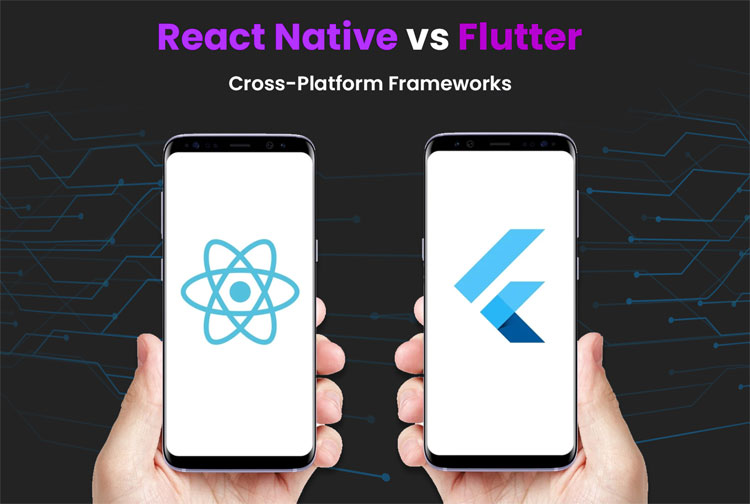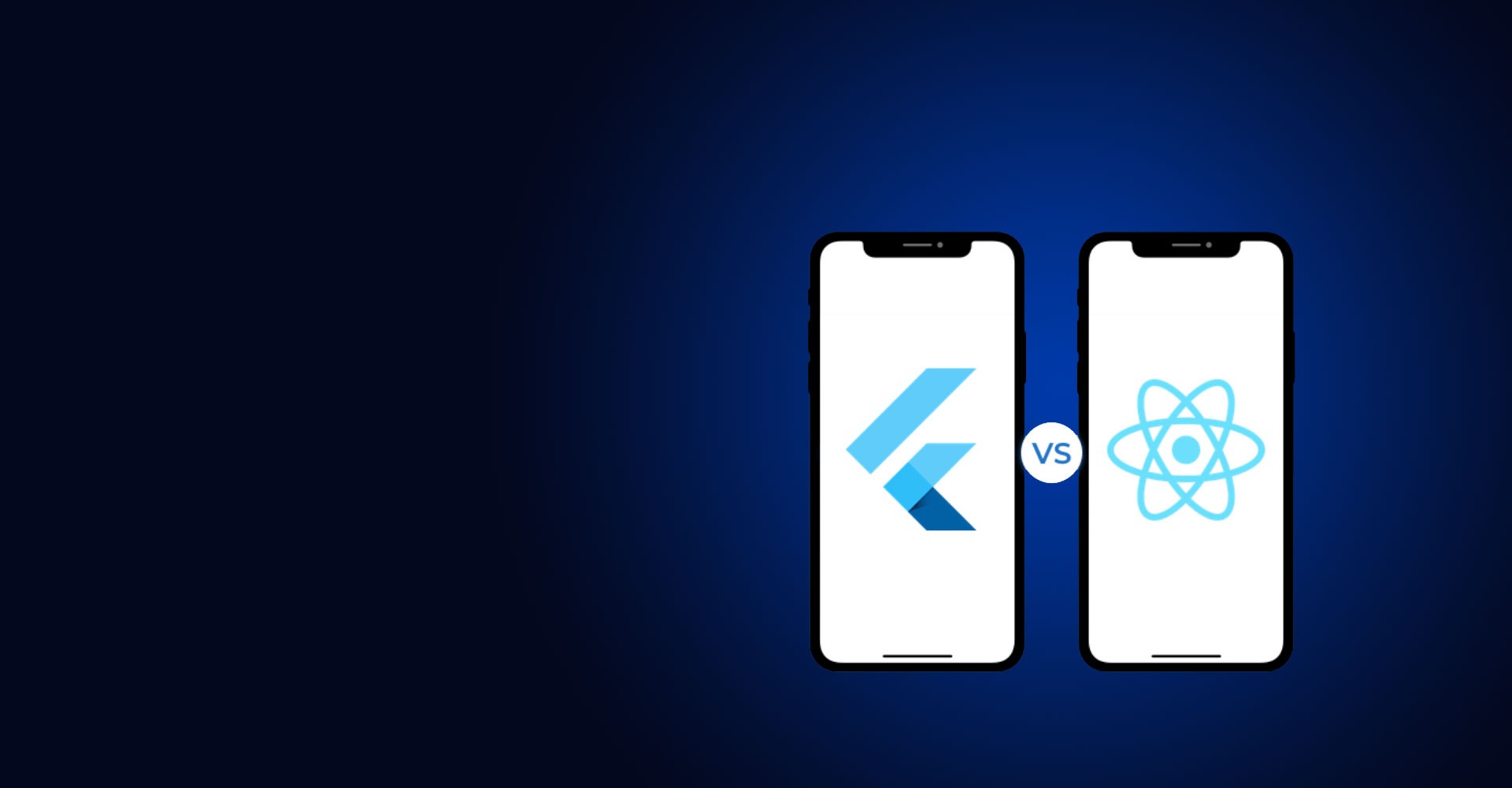Flutter vs. React Native – Which is Better?

Introduction
In recent years, mobile app development has emerged as one of the most prominent technological trends. With the increasing demand for mobile apps, app developers are constantly looking for new and efficient ways to build them. The two most popular frameworks for building mobile apps are Flutter and React Native. ‘Flutter vs react native, which is best?’ has often been a hot debate topic among the masses.
In this blog post, we will majorly highlight the Flutter vs React native comparison for mobile app development. We will examine their similarities and differences, programming languages used for development, development environments, UI development process, performance, community support and resources, cross-platform development capabilities, and use cases and applications.
What are Flutter and React Native?
Flutter and React Native are the best & most used mobile app development frameworks that enable developers to build high-quality mobile applications. While they share the same goal, their approach, and architecture are different.
Developed by Google in 2017, Flutter is an open-source framework for developing mobile apps. It involves Dart, a modern programming language that compiles native code, to build high-performance apps with a beautiful and expressive UI. In addition, Flutter uses its own widgets and design language, called “Material Design,” to create beautiful and consistent UI across all platforms.
React Native, on the other hand, is an open-source application development framework created by Facebook in 2015. It uses JavaScript and React, a popular web development library, to build native mobile apps. In addition, React Native enables developers to implement apps for both iOS and Android platforms with the same codebase, which ultimately results in reduced development time and cost.
Language and Development Environment
Flutter vs react native comparison in terms of the programming language used in their development is crucial as they differ from each other. Flutter uses Dart, while React Native uses JavaScript. Dart is a modern programming language that has a concise syntax, which makes reading and writing code easy. Conversely, JavaScript is a popular programming language for web development and is widely used for building web applications.
The development environment for Flutter and React Native is also different. Flutter uses the Flutter SDK, which includes everything developers need to build, test, and deploy Flutter apps. The Flutter SDK consists of the Flutter engine, a set of widgets, development tools, and an integrated development environment (IDE) called “Android Studio.”
React Native uses the React Native CLI, a command-line interface that helps developers to create, build, and run React Native apps. Developers can also use various IDEs such as Visual Studio Code or Atom for React Native development.
UI Development
UI development is an essential aspect of mobile app development, and both Flutter and React Native offer different approaches to UI development; hence, selecting which would be the best for mobile app development based on the UI and other specific tech needs is vital.
Flutter uses a declarative UI programming model, which allows developers to build UI elements by composing widgets. Flutter’s widgets are designed to be customizable and flexible, making it easy to create beautiful and consistent UI across different platforms. Flutter also offers a hot reload feature, which enables developers to make changes to the code and see the results immediately.
React Native uses a “learn once, write anywhere” philosophy, which means that developers can use the same codebase to build apps for both iOS and Android platforms. In addition, react Native uses a component-based approach to UI development, which allows developers to create reusable UI elements.
When it comes to UI development, both Flutter and React Native have their pros and cons. Flutter’s widgets offer more flexibility and customization options, while React Native’s component-based approach makes it easier to build apps for both platforms.
Performance
Performance is another critical factor in mobile app development. Both are best for mobile app development; understanding their functioning across platforms and devices is necessary for optimum performance.
Flutter apps run directly on the device’s hardware, resulting in faster app startup time, smoother animations, and better overall performance. Flutter’s hot reload feature also helps developers optimize the app’s performance by quickly iterating and testing the code.
On the contrary, React Native uses JavaScript, an interpreted language that needs to be executed by a runtime environment. This can result in slower app startup time and lower overall performance compared to Flutter.
Community Support and Resources
Community support and resources are essential for any framework or platform, as they can help developers to solve problems and learn new things. Here we analyze the Flutter framework vs react native.
Flutter has a growing community, and many resources are available for developers, such as documentation, tutorials, and forums. Flutter also has many plugins and packages available, which can help developers add new features to their apps quickly.
React Native has a more established community, and many resources are available for developers, such as documentation, tutorials, and forums. React Native also has many plugins and packages available, which can help developers add new features to their apps quickly.
Cross-Platform Development
Cross-platform development is an essential aspect of mobile app development, as it allows developers to build apps for both iOS and Android platforms with the same codebase. However, both frameworks have their own sets of benefits; thus, Flutter vs react native, which is best suited, depends on specifics.
Flutter offers excellent cross-platform development capabilities with customizable widgets. This means that developers can build apps for both platforms with the same codebase, reducing development time and cost.
React Native also offers excellent cross-platform development capabilities. For example, developers can use the same codebase to build apps for both iOS and Android platforms, reducing development time and cost.
Applications
Regarding use cases and applications, Flutter vs React native comparison here is slightly different. Both can be used to build a wide range of mobile apps. However, every framework has its strengths and weaknesses regarding specific types of apps.
Flutter
- Customised UI: Flutter’s customizable widgets and flexible design make it an excellent choice for apps that require a consistent and unique user interface. This includes e-commerce, social media, or dating apps, where the visual appeal and intuitive design can be critical to the app’s success. With Flutter, developers can easily create custom UI elements and animations, resulting in a highly polished and visually appealing app.
Example: The Reflectly app is an excellent example of a highly customized UI built with Flutter. The app features a unique and visually appealing interface, with customizable backgrounds and intuitive animations that make it stand out from other journaling apps. - Gaming apps: Flutter’s ability to render 2D and 3D graphics with high performance makes it an excellent choice for building gaming apps. With its built-in 2D and 3D rendering engine, Flutter allows for smooth and responsive gameplay, even on lower-end devices. Developers can use Flutter to build highly optimized and visually impressive games.
Example: One of the best examples of a gaming app built with Flutter is the Greedy Cats game. The game features engaging gameplay and impressive 2D graphics, all made with Flutter. - High-performance apps: Flutter’s architecture, including its use of the Dart language and its rendering engine, makes it faster and more performant than other frameworks, making it a good choice for apps that require high performance. This includes fintech or real-time chat apps, which must be highly responsive and performant.
Example: The Google Ads app is an excellent example of a high-performance app built with Flutter. The app provides real-time data and analytics while being highly responsive and performant.
React Native
- Social media apps: React Native’s ease of use and fast development times make it ideal for building social media apps that require frequent updates and new features. With React Native, developers can easily add new features and functionality, making it easy to keep pace with user demand.
Example: The Instagram app is one of the most popular social media apps built with React Native. The application features a simple and intuitive interface with easy-to-use filters and photo-editing tools. - On-demand apps: React Native’s modular design and access to native device features make it an excellent choice for building on-demand apps such as ride-sharing, food delivery, or e-commerce apps. With React Native, developers can easily integrate with device features such as GPS, cameras, and push notifications, making it easy to build highly functional and responsive apps.
Example: The Uber Eats app is an excellent example of an on-demand app built with React Native. The app features a simple interface with easy ordering and delivery tracking functionality. - Media streaming apps: React Native’s integration with native libraries and access to low-level APIs make it a good choice for building media streaming apps such as Netflix or Twitch. With React Native, developers can easily integrate with video playback APIs and optimize the app’s performance for streaming content.
Example: The Netflix app is an excellent example of a media streaming app built with React Native. The app features an intuitive interface with easy navigation and video playback functionality.
Conclusion
With the demand for Flutter rising to drive business growth, many companies are now offering Flutter framework development. It is more compatible and thus widely used. When choosing between Flutter and React Native for mobile app development, it is essential to consider the specific requirements of your project and your development team’s expertise.
At BuzzyBrains, each project requires a tailored approach to maximize its potential. Identifying the best framework for your project is our goal, as our team of experienced developers helps you navigate the complex world of mobile app development.
Whether you are looking to build a highly customized UI, a high-performance app, or an on-demand service, BuzzyBrains is one of the best flutter mobile app development agencies in India for all your tech needs. By leveraging our experience and skills, we can help you build a mobile app that meets your business objectives and exceeds your users’ expectations.

